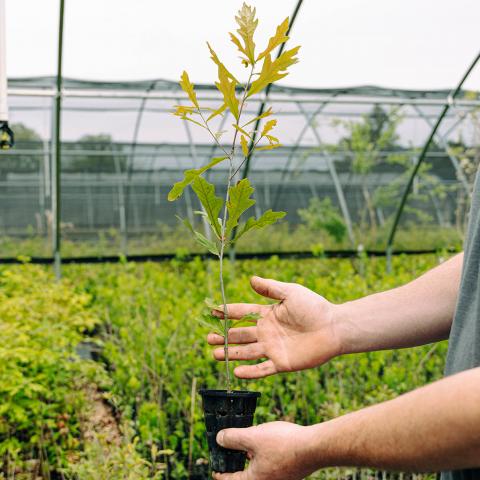Todd Amenrud | Originally published in GameKeepers: Farming for Wildlife Magazine. To subscribe, click here.
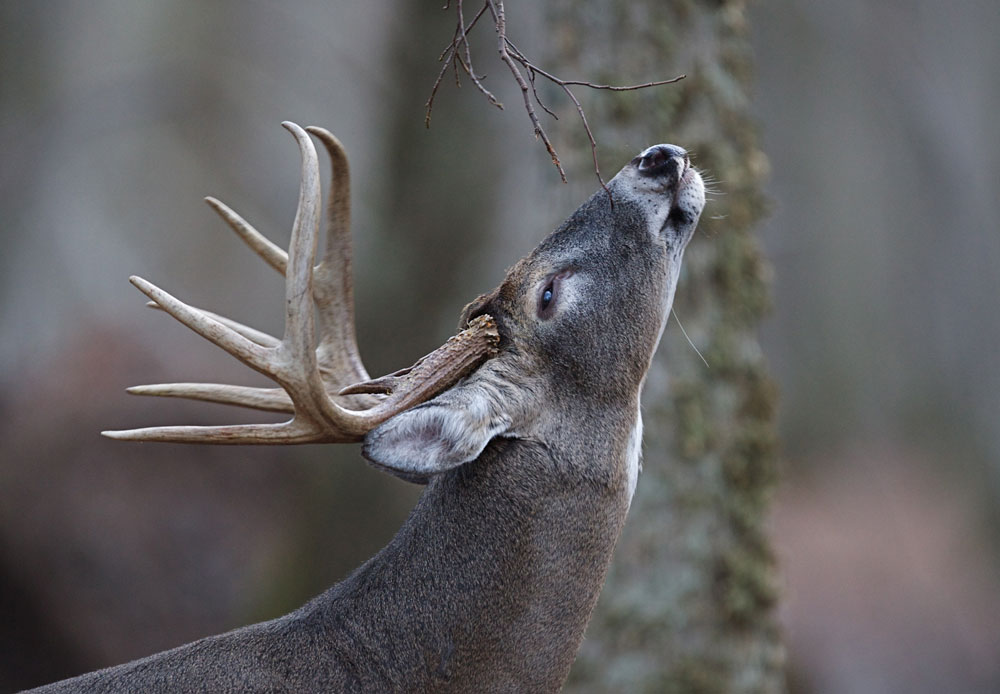
We’ve all heard statements like, “A whitetail ‘lives’ by its nose.” It’s true! To be able to identify another deer or the threat of a human or other predator from just a miniscule, molecular whiff of odor would probably make most humans freak out. The olfactory portion of a whitetail’s brain is said to be approximately 1,000 times larger than a human’s! That’s difficult for most humans to even comprehend.
So, knowing that a whitetail's number one guard is its extremely responsive sense of smell, it boggles my mind why some hunters don’t do more to contest it. Besides combating this olfactory offense by reducing odors on our person and eliminating scent-transfer, we also need to understand how whitetails use air currents to their advantage. This is one of the keys in predicting whitetail movement.
Most of my hunting companions know that I am more cautious about scent elimination than any other “three people combined.” Everything I bring into the whitetails' domain will be treated to destroy odors at the molecular level. I literally use gallons of Wildlife Research Center’s Scent Killer during the hunting season. We need to reduce any smells that we carry into their domain to a minimum, especially something as offensive to deer as human scent. Pay attention to odors on you, your clothing and equipment.
It is also important to pay heed to scent transfer, in other words, the odors you may be leaving behind. Aside from the previous step of reducing odors, rubber-bottomed boots will help when walking through their territory and rubber gloves or trapper’s gloves will help if you need to touch anything. To sum it up, try not to transmit odors to a spot where you think a deer will be able to smell it easily. It’s like you’re “pushing” odors into any object you touch.
In addition to reducing odors, we must learn how to play the wind and thermal currents. Basically, they're the means that carry smells to a whitetail. You have to know how to place yourself within their terrain so you can see them before they smell you. Moreover, understanding these currents is a key to comprehending deer movement.
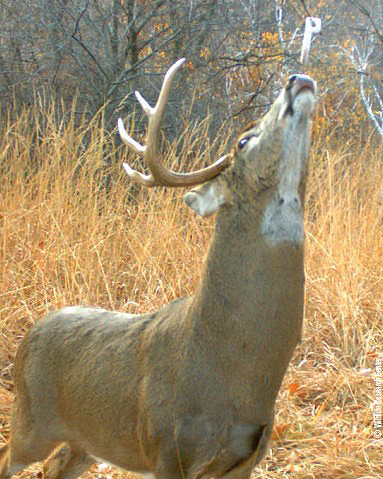
Learning how air currents behave and travel will aid you
in predicting whitetail movements.
Obviously, we must estimate the wind effectively while we’re physically hunting, but learning how these currents work will assist you in forecasting which routes whitetails will use and when they will use them. Knowledge of how air currents act will significantly help you in calculating whitetail movements.
Air currents can be caused by the rotation of the earth, temperature variations, air pressure, weather changes, global shifts and a multitude of atmospheric and land based influences. Warmer air is less dense than cool air making it lighter. So if there is warm air under cool air, because of gravity the warm air rises. In the northern hemisphere, a high pressure system next to a low one causes wind direction to flow clockwise and outward. A low pressure system causes wind direction to flow counterclockwise and inward. All of these major airflow patterns can be affected by smaller influences like obstructions, topography and temperature variances.
Everybody knows what the wind is, but most whitetail hunters don't pay enough attention to thermal currents. The heating and cooling of the air makes it do some strange things. When various objects retain temperatures different than the air, this also makes the currents flow distinctively. In western states, because of the mountainous terrain, most veteran big game hunters are very familiar with thermal. However, it's extremely important in flat areas too.
It could be as simple as when you’re hunting a small clearing, when the sun comes up it shines on one side of the clearing first. The sun warms the air and the current rises on that side of the clearing before it does anywhere else. Or the opposite, if an area begins to shade and the air temperature starts to cool, the current may begin to draw to the ground.
Pay particular attention around water, rocks or anything that may retain a temperature different than the air. When the air temperatures differ, you'd be amazed at how your scent may be swirling around. Dark conifer trees are notorious for holding warm temperatures.
Physical barriers also have a huge impression on air currents. Tree lines, rock out-croppings, ridges, mountains or buildings obviously obstruct and influence currents. When this happens the air currents tend to move just like river currents where you may have eddies, dead spots or a whirlpool effect. If these barriers hold temperatures different from the air, this may also have an effect on how they flow. For instance, if the warm sun is shining on a dark, muddy swamp all day long—in the evening when things would normally cool and the air current descend, the warm air held by the dark swamp may still inspire an upward draft.
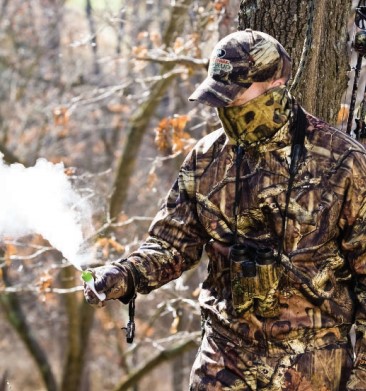
Firefly Electronic Wind Detector down to the seed hair
floss from a milkweed plant. A simple “dust puffer” like
this will do the trick. With down, small flecks of
unscented cotton or particles like these you can watch
the currents flow for some distance.
So how do you know what the air current will do? I believe this is where many mediocre hunters goof up. Some hunters find a spot where they have big buck sign everywhere, then they lick their fingers, stick them in the air and point downwind to the spot where they'll place their stand. Sometimes this might work, at least this hunter has realized to be fairly consistent we want to try and remain downwind or crosswind whenever possible. But often the sign you’re observing might have been made under totally different conditions than the wind blowing in that particular direction. A whitetail is NOT going to spend a great deal of time in an area where it can't use its nose efficiently. A deer may never use that trail or enter that area under the conditions you've set up on him for.
You can't set up downwind of an area and think "they won't smell me here," and expect to have regular success. First, you have to think about why and how a deer might use a given wind to their advantage in that specific area. I want the buck to think he has the advantage, so he needs to feel comfortable with the spot AND the conditions when I'm going to hunt the spot. Then, set up where I believe I can remain undetected from his nose.
My best advice is to get some type of simple wind detection device, dust puffer, down-patch or some unscented cotton. Dust particles or small flecks of down or cotton can be released into the air so we can observe the air currents. I used to release a tiny fluff of down from a patch taped to my bow, in addition, I had a string tied to a small feather also attached to my bow. The stationary string and feather will only tell you what the wind is doing at that single spot, but a dust puffer, down or something you can release into the air will flow for a distance allowing you to visualize the current. Once you can see the breeze, it really helps you to understand how the air currents actually travel and why heating and cooling needs to be factored in.
With a wind detection device you can actually see how your scent is being carried to a deer. With today’s modern technology, there are also tools like the Firefly Electronic Wind Detector that will tell you wind direction by electronic means. A good woodsman will also know of things that can be used in nature like the fluffy seed hair or “floss” from a milkweed plant or cattail duff. I prefer a down-patch or a dust puffer, this way I can watch the particles flow for some distance. Besides being great tools to physically play the wind, when you can actually see the air current flow for some expanse it really helps to teach you why, when and where deer will move.
Begin with a large regional review of wind direction and speed and then reduce it to your property, then to smaller sections like a valley, ridge or small woodlot and then to your specific ambush site. Start with the weather report on your local TV station or the Weather Channel. Then take an observation from a wind vane, flag or wave action on a body of water on your property. Finally, use your “duster,” down patch, milkweed hair or whatever means you choose to test and document the wind direction at your ambush site. Because of physical barriers, thermal influences or temperatures emanating from different sources, the actual air current may be flowing in a completely different direction than what was claimed on your local weather or what you saw based on observing your wind-vane or flag. Once you start cataloging this you’ll begin to know exactly what the air current is actually doing at your ambush site because of repetition and good record keeping.
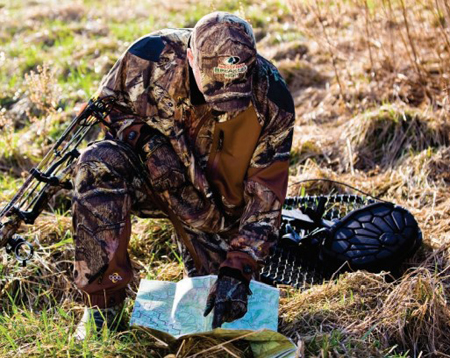
exactly what the air current is actually doing at each of your
ambush sites which makes predicting deer movement much
easier.
Along with direction, wind “speed” can also be essential. A strong wind can nullify most thermal influence. Maybe you’re sophisticated in your record keeping and have an anemometer, which is basically an instrument to measure wind speed. I like to know and document a number of precise weather details. Whitetails are creatures of habit and will do things over again as long as the circumstances are remotely the same and the reward is still there. Knowing as many of these conditions as possible will help you in predicting whitetail movement.
For a property manager, understanding air currents can be a key to selecting successful ambush sites and achieving harvest goals. I suggest printing out several maps or satellite images of your property and map out air flow patterns during various times of the season. You should also fine-tune these charts after every time you hunt. Just because the Weather Channel says the wind will be blowing from the west, as an example, when you get to your hunting site it could seemingly be blowing from a completely different direction because of influences from thermal or physical obstructions. Document this so the next time the wind is said to be coming from a certain direction, you'll know what it's really doing at your hunting site.
Whitetails use the air currents to their advantage when they travel. So once you have an understanding of what the actual air currents will do under various conditions and different times of the year, and you put in some time observing whitetails with this known, now you can begin predicting deer movements much more efficiently. You start to understand why whitetails do what they do, and when they’ll do it.
Good record keeping is also a key. Whitetails are creatures of habit. Once you see them do something, for instance, use a certain trail from point A to point B, if conditions are remotely similar on a comparable day they will likely do the same thing again. It’s important to only put pressure on your ambush sites when the conditions are in your favor for success. They are creatures of habit, but their instinct for survival outweighs all else. If you intrude and they sense it, they will change something to avoid making contact with you. Don’t let them know you’re hunting them.
Playing the wind is important, but we must also understand how a whitetail uses the breeze and thermal currents to his advantage. When I first started hunting, my grandfather told me, "Deer always travel into the wind so they can smell what's up ahead of them." I'm sorry grandpa, but with the prevailing currents that we have in the United States eventually every deer would end upon the West Coast. The fact is, that whitetails travel with the wind, against the wind, and side-cut the wind - they still need to get from point A to point B regardless of the wind direction. They will take the route that gives them the best advantage to use the air currents and cover. Keep good records and watch the air currents, they will lead you to predicting whitetails much more accurately.















